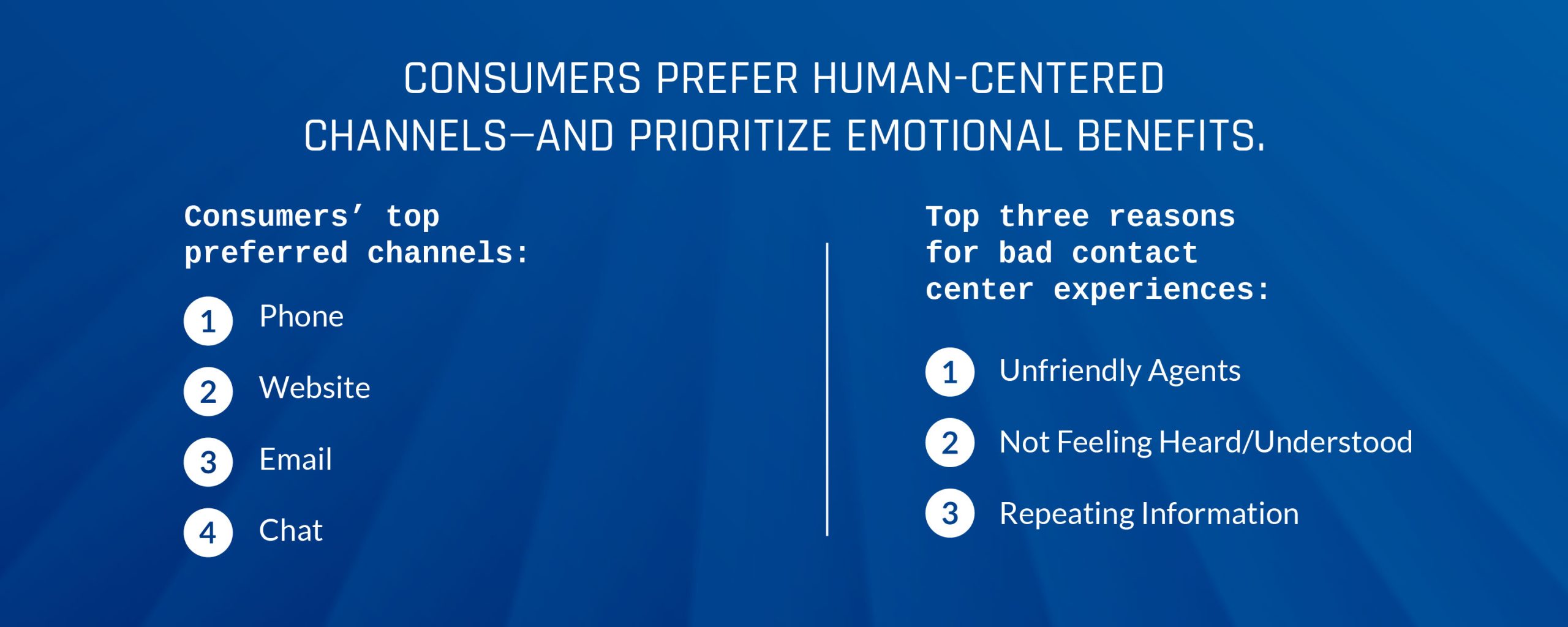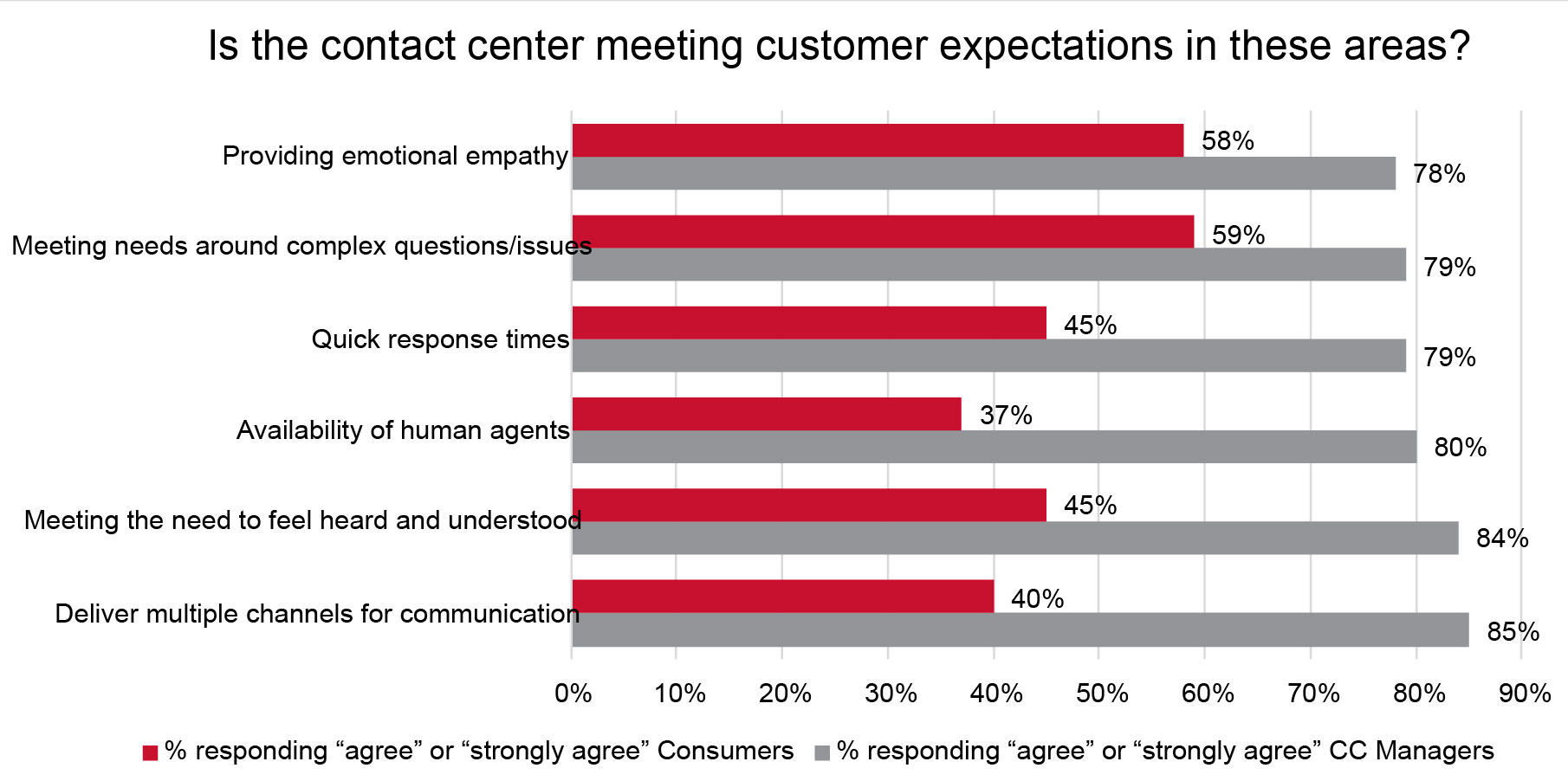4 Ways AI and Analytics Can Drive Better Human Experiences
4 Ways AI and Analytics Can Drive Better Human Experiences

Consumers Want Human-Driven Experiences: Here Are 4 Ways to Deliver Using Analytics & AI
The 2022 Calabrio State of the Contact Center survey left no doubt that consumers still prefer human-to-human interactions. Consumers ranked human-driven channels as most influential on their brand associations (phone, website, email and chat). They also told us they prioritize emotional benefits over functional ones: Unfriendly agents, not feeling heard and understood, and having to repeat information were the top reasons for bad experiences—while things like wait times and resolution speed were much less likely to leave them seriously frustrated.
But the survey also revealed a concerning disconnect around how well contact centers think they’re delivering this human element—and where they’re placing their investments and focus. This leaves many organizations asking how AI can improve the customer experience and drive more human experiences.

Contact Centers Rate Their Performance a Lot Higher Than Consumers Do
Half of contact center managers reported they’re seeing consumer expectations rising around human-driven service experiences. They said consumers expect more human agent availability (over bots and self-service), they have a greater need to feel heard, and they’re bringing more complex needs and questions to the contact center.
If contact center managers know that consumers want more human-driven interactions, they’re adjusting their focus accordingly and delivering on these expectations, right? Not exactly.
Our survey showed there’s a huge gap between how well contact center managers think they’re delivering on human factors—and what consumers say:

This disconnect isn’t a fluke of one survey. A PricewaterhouseCoopers report found that 64% of U.S. consumers and 59% of all consumers feel companies have lost touch with the human element of customer experience.
At an even simpler level, contact centers are prioritizing the wrong channels. While consumers make it clear that they prefer human-driven channels over tech-driven ones, managers said they think tech-driven channels like apps, social media and self-service knowledge centers are the most important to customer experience.
Bad Experiences Have Big Impacts
We’ve all heard the scary statistics about how quickly consumers jump ship after a bad experience. But our survey showed an even scarier phenomenon: Just one negative interaction taints all the rest, making it difficult for brands to recover. Consumers that had a recent bad contact center experience rated general contact center performance (that is, their perception of how well all contact centers in general are performing) dramatically worse across every aspect:

Contact Centers Need to Invest in AI & Analytics to Support—Not Replace—Human Experiences
As more brands recognize that contact center experiences are essential to brand perception—and can directly drive revenue—it’s been great to see increasing investment in contact center technology. Brands are expanding channels, adding self-service options, and deploying AI-driven chatbots and virtual assistants. These are powerful tools that undoubtedly have a valuable place within the forward-thinking contact center—and are clearly part of the omnichannel experience that consumers (especially younger ones) want.
But contact centers need to be careful not to focus on technology as a solution to replace human-driven experiences. Instead, technology should function as a tool to enhance human experiences. As PwC aptly concluded in their report, Experience is everything: Here’s how to get it right, “Technology isn’t the final solution, it’s an enabler.”
With that in mind, here are four strategies for how to improve the customer experience in the call center leveraging next-generation technologies to empower agents and enable better human-driven experiences:
1. Giving Operations and Agents Omnichannel Customer Visibility
To deliver genuine, conversational service experiences, contact center agents need full visibility of customer information. Contact centers need to ensure their tech stack is fully integrated, bringing all channels and all customer data into a simple agent dashboard that gives the agent a single view of the customer and their journey. It needs to be easy to see details of recent interactions at a glance—and dive into the full customer history when needed.
This omnichannel, 360° visibility is foundational to making the customer feel known, heard and understood—and, of course, never asking the customer to repeat themselves. But it’s not all about soft benefits. This deep visibility gives agents immediate access to relevant information they need to solve complex issues and get to a resolution faster.
Enhancing Performance Coaching with AI
Contact centers also need to focus on turning good agents into great ones—helping them enhance their interpersonal skills, improve empathy and develop problem-solving prowess. The challenge is knowing which agents need additional coaching and training.
Many contact centers are now using AI to do predictive NPS scoring and quality evaluations of 100% of interactions. These AI-powered capabilities present a full, clear picture of agent performance—and automatically identify relative strengths and weaknesses, comparing agent performance across a reliable baseline of all customer interactions. These insights provide a starting point for incredibly personalized, relevant and impactful coaching to foster ongoing agent improvement.
3. Using Analytics to Empower Agent Engagement & Self-Improvement
Good centers also need to focus on turning good agents into great ones—helping them enhance their interpersonal skills, improve empathy and develop problem-solving prowess. The challenge is knowing which agents need additional coaching and training.
Many contact centers are now using AI to do predictive NPS scoring and quality evaluations of 100% of interactions. These AI-powered capabilities present a full, clear picture of agent performance—and automatically identify relative strengths and weaknesses, comparing agent performance across a reliable baseline of all customer interactions. These insights provide a starting point for incredibly personalized, relevant and impactful coaching to foster ongoing agent improvement.
4. Fixing Tech Issues & Guiding Investments with desktop Analytics
Contact center technologies are supposed to make agents’ jobs easier. Yet all too often, hidden tech-based issues are the major limiting factor in agents’ ability to deliver great experiences.
Innovative contact centers are now using desktop analytics tools to root out these tech barriers and bottlenecks. These desktop analytics tools automatically connect agent desktop activity with speech, text, sentiment, and other VOC and VOE analytics. The desktop analytics tools can identify those situations where customer interactions are heading in a negative direction because an agent cannot easily connect to a resource, because of excessive tech lag time, or simply when an agent cannot access the resource or information they need. These desktop analytics insights can guide process changes, as well as smart technology investments to plug gaps and resolve bottlenecks—so technology can fully empower agents to focus on delivering the human element.
Get More Actionable Insights From the 2022 State of the Contact Center Report
Our 2022 State of the Contact report uncovered several disconnects and revealed valuable insights on where contact centers should focus now to build experiences that deepen loyalty and drive revenue.
Download the full report here.








